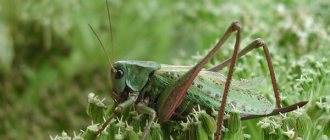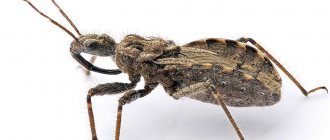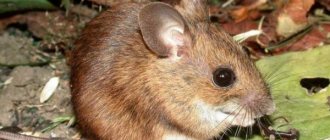Many people know what a green grasshopper looks like, because this insect is distributed almost everywhere, with the possible exception of the northern territories. However, not everyone realizes that this seemingly harmless insect can cause significant harm to agriculture.
Of course, it does not harm on the same scale as locusts, and yet, without timely protective measures, some cereal crops, tobacco, vineyards, tea plantations and citrus fruits will suffer.
Description of the appearance of the insect
The body of an adult insect, like the body of a larva, has a rich green color. Only on the wings and chest there may sometimes be dark spots. Body length – 28–36 mm. The antennae are very long, bristle-like, with a reddish tint. The length of the green grasshopper's whiskers exceeds the length of the insect's body. The grasshopper has 2 pairs of wings - front and rear. The hind wings are wide, transparent, with thin veins forming an abstract geometric pattern; the front ones are denser and narrower. At rest, the hind wings are hidden under
In front of them. The length of the wings exceeds the length of the insect's abdomen by almost 2 times. The head has an elongated shape. The eyes are round and protruding. The upper part of the pronotum has a convex or flat shape. The type of mouthparts is gnawing.
Females differ from males in the presence of a long saber-shaped or xiphoid ovipositor compressed from the sides. The hind limbs of males are much longer than the forelimbs. The hearing organs are oval membranes located on the shins of the forelimbs on both sides. In males, the elytra are equipped with a chirping organ, which is formed by a stridulatory part and a transparent resonating membrane (speculum).
Ball-headed grasshoppers
Otherwise called fat people, because they have a fleshy, wide body. The head of insects, as the name implies, is spherical. Its antennae are set below the eyes. Ballheads also have shortened elytra. The hearing organs are located on the front legs. There are cracks visible. These are the ears.
Sevchuk Servilya
This is a medium-sized grasshopper. The two-centimeter body of the insect is dense, wide, and looks short. The grasshopper is painted brown. The flattened pronotum has yellow markings.
The lateral carinae of Serville are pronounced. By the way, the insect was named after an entomologist from France. Guyom Odinet-Servile devoted his life to the study of Orthoptera.
Sevchuk servilla received its name in honor of the French entomologist
Fat guy
The species is European, on the verge of extinction, included in the species of large grasshoppers . Males of the species are 8 cm long. The length of females is 6 centimeters.
The names of grasshoppers are often based on their appearance. A fat man, for example, looks plump, even fat. Due to this, the visually black-brown body of the insect appears shorter. Volume is also added by sharp keels on the sides of the grasshopper's pronotum.
Fat grasshopper
Lifestyle
Green grasshoppers lead a solitary lifestyle. They jump and fly very well.
The length of the jump is several times greater than the length of the insect itself, and the flight speed can reach up to 1.5 km/h.
Grasshoppers do not have a home; they are always found among grass, bushes and trees. In particularly hot weather, the insect hides in the greenery all day, emerging from shady shelters only early in the morning.
We hear the ringing melodies of the grasshopper throughout the summer. The sound occurs as a result of vibration and becomes even louder if the insect raises its wings. Males sing to attract females or to let other males know that the territory is already occupied. The chirping of a grasshopper can most often be heard in the daytime and evening, less often at night.
Exotic grasshoppers
There are species of grasshoppers that are hardly recognized as such. It's about unusual shapes and colors. Non-standard grasshoppers usually live in the tropics.
Peruvian grasshopper
Opened in 2006 in the mountains of Guyana. The grasshopper imitates the color of a fallen leaf. Externally, the insect also resembles it. The outer side of the folded wings is dotted with a grid pattern. It repeats the capillary pattern on dried greenery.
In order to resemble a fox in shape, the grasshopper folds its wings, covering the sides and a large space above the back.
The underside of the wings of the Peruvian grasshopper is colored like the Peacock butterfly. She chose this design to scare away predators. Seeing “eyes” on the wings of an insect, they mistake it for a bird or other animal. The Peruvian grasshopper uses the same trick. It also bounces characteristically to resemble the head of a large bird.
The Peruvian grasshopper opens its wings and looks like a butterfly.
Grasshopper rhinoceros
It also resembles a leaf, but green. The color is juicy, closer to light green. The insect's antennae are line-like threads. They are barely noticeable, translucent, significantly longer than the body.
The name of the insect is associated with the presence of a horn-like structure on its head. It is also green, attached to the back of the head, like a leaf stalk.
Spiny Devil
Looking at the types of grasshoppers in the photo , it’s hard not to stop looking at the devil. It is emerald in color and covered with triangular needles. They are located all over the body.
The length of the devilish grasshopper does not exceed 7 centimeters, although it is a tropical inhabitant. However, the sharp needles and the insect's manner of waving its limbs in front of its enemies scare away the latter. The devil does this in the forests of the Amazon basin.
Spiny devil grasshopper
Exotic grasshoppers are also found among ordinary ones. Here it is no longer a matter of species, but of genetic anomalies. In the world of grasshoppers, erythrism occurs. This is the absence of pigment. Erythritated grasshoppers resemble albinos, but not the former ones. Pink coloring occurs in one individual out of 500. Erythrism in grasshoppers was discovered in 1987.
Finally, we note that in the eyes of ordinary people, grasshoppers are not only true representatives of the suborder, but also crickets and fillies. The latter have shorter antennae and stockier bodies. Crickets have a spherical head and a flat and short body.
Reproduction
Mating of green grasshoppers occurs within 45 minutes. After mating, the female begins to eat the spermatophore. This process can last up to 15 hours. The male resumes his chirping within 15 minutes after mating.
Egg laying occurs at the end of summer. To do this, the female selects a suitable place in the soil and lays up to 100 eggs in a shallow hole. The eggs are elongated, cylindrical, greenish in color. Egg length up to 6 mm.
Adults die with the onset of cold weather, and the eggs continue to be in the soil at a shallow depth throughout the fall and winter. In the spring, when the surface layer of the earth begins to warm up, larvae hatch from the eggs. During their development, they molt 5 times. Then, bypassing the pupal stage, the larva will turn into a young grasshopper.
Role in a person's life
Taking into account all the stages of development of a grasshopper, its life expectancy is just over a year. The adult lives only one summer. Some hobbyists keep these insects at home in a terrarium. It can be installed in a regular glass aquarium with a lid. It is better to use a larger container.
The bottom of the terrarium is covered with river sand. Based on what grasshoppers eat, they are offered live butterflies, spiders and flies as food . You can additionally give vegetables, fruits, salad leaves, and spikelets of cereals. It is better to seat females during the breeding season to avoid fights and cannibalism. Each of them should have its own territory at this time.
Much more often, grasshoppers are used for gastronomic purposes. Who considers them a tasty delicacy? These insects are eaten in China and some countries in Asia, Africa and Latin America. In street markets and small Chinese and Mexican restaurants, you can enjoy fried grasshoppers flavored with chili pepper and lime juice.
In Japan, jumpers are collected from rice fields and then cooked in soy sauce and sugar. Latinos collect insects from alfalfa fields and fry them in a little oil, adding garlic, salt and lemon when serving. In this way, local farmers “kill two birds with one stone” - they rid their crops of pests and provide themselves and their families with food.
Insect nutrition
Green grasshoppers are predatory insects. They feed mainly on butterflies,
caterpillars and other small insects, sometimes eating larvae or weaker representatives of their species. Grasshoppers wait for their prey, sitting quietly in the grass, grab it tightly with their 4 front legs and immediately eat it.
If difficulties arise in finding insects, grasshoppers can feed on plant foods: flowers, foliage, tree buds, plant stems, grass and some cereals.
Greenhouse grasshoppers
They are hunchbacked and stocky. The body of greenhouse grasshoppers is shortened, but females have a long ovipositor. Representatives of the genus are also distinguished by long legs and mustaches. The latter reach 8 centimeters.
Chinese greenhouse grasshopper
A little less than 2 centimeters in length. The shortened body surrounded by long, thin legs makes the insect look like a spider.
The Chinese grasshopper is painted brown. There are dark spots. They, like the rest of the body, are covered with short, silky hairs. The insect sheds them, along with its chitinous shell, about 10 times during its life. This is a record for grasshoppers.
Far Eastern grasshopper
Included in the grasshopper species of Russia . The insect is otherwise called a cave insect, since it settles not only in greenhouses, but also in karst rock cavities.
The Far Eastern grasshopper is medium-sized, brown-gray in color. The insect is nocturnal. This distinguishes the species from most grasshoppers.
Maliciousness
Very often, the green grasshopper damages vineyards by eating flowers, leaves and buds. The grasshopper often harms tobacco crops, citrus fruits, tea leaves and other plants.
The most dangerous caterpillar, contact with which can lead to death, is Lonomy. Have you planted a beautiful boxwood bush and are afraid for its safety? Find out how to protect your plant from its biggest enemy. Read more here.
If you need to treat indoor or garden plants against spider mites, then choose Masai acaricide. What are its advantages, read the link.
Control measures
Methods to combat this insect have not yet been sufficiently developed. For preventive and exterminatory purposes, the following is recommended:
- It is advisable to locate tobacco plantations away from egg-laying sites (thrush and virgin areas) of the green grasshopper;
- treatment of the shag field and surrounding area with internal poisons;
- placement of bait with poison in pest habitats. This will require 30–60 kg of bran, 24 liters of water, 0.8–1.2 kg of arsenous soda.
Grasshopper, cricket, locust pictures, photos, videos
Today we have, one might say, a summer theme and its most beautiful chirping representatives of insects - grasshopper, cricket, locust pictures, photos, videos. Let's start with the well-known grasshopper. Although, I doubt that all of you know so well about him, most likely, reading further lines, you will have a slightly different attitude towards these beautiful serenade performers. But let's dispel, in order, the existing myths and legends around this representative of the order Orthoptera, the suborder Long-whiskered.
The grasshopper lives almost throughout the entire territory of Russia, with the exception of deserts, high mountains and regions of the far north. The most common species are green grasshopper, gray grasshopper, steppe grasshopper, tailed grasshopper and songbird. So, we begin to slowly destroy the idea - the grasshopper is a nocturnal insect, most often during the day it hides in secluded places, and at dusk it comes out to hunt at night. The grasshopper is a predator, its hunting style is very similar to the praying mantis, the grasshopper also lies in wait for its prey and grabs a gaping insect with its strong front paws.
After which, with its powerful jaws, the grasshopper tears the victim apart and eats it. (by the way, a grasshopper can easily bite through a person’s skin and believe me, the feeling from this is not the most pleasant)))) The grasshopper eats almost any insect that is smaller in size than it, and sometimes even larger representatives than itself. Often the grasshopper also catches its smaller brothers; it does not disdain anyone when choosing an object for a meal. If there is not enough animal food, the grasshopper can gradually switch to vegetation, eating the buds of shrubs and various cereals, but this is the exception rather than the rule.
The grasshopper prefers to ambush, sitting on branches or leaves of bushes, low-growing branches of trees, except that in meadows and in the steppe zone it lives in the grass. So, friends, when you are walking through a forest clearing and insects are quickly jumping in different directions from you, it is unlikely that it is a grasshopper, most likely they are representatives of locusts or grasshoppers, our main character is at this time somewhere peacefully in a shelter dozing. The grasshopper is generally reluctant to jump, only in case of emergency; usually he prefers to crawl, and his hunting style is wait-and-see, but not at all active.
The male and female grasshopper differ in appearance from each other; the female has an ovipositor at the end of her abdomen, a kind of saber, while males do not have this device. The grasshopper also has very long antennae, which, like antennas, help it detect the slightest movements at night. The grasshopper has an incredibly beautiful and varied song; the sounds are produced due to the vibration of the elytra, and each type of grasshopper has its own chirping melody, different from others.
At the end of the selection, we invite you to look at a comparative table that shows the differences between grasshoppers and locusts and you can easily distinguish them from each other.
Grasshopper
Funny grasshopper Grasshopper photo Cool grasshopper
Amazing grasshopper
Grasshopper
Jumping Grasshopper
Cool grasshopper
Grasshopper photo
Grasshopper
Green grasshopper
The cricket is the closest relative of the grasshopper; among crickets there are two main species, true crickets, which live in almost all climatic zones, with the exception of cold areas. Crickets live in burrows, which they dig themselves, or they use ready-made natural shelters, crevices, shelters under stones or fallen trees for housing. The cricket is a territorial insect; each representative has its own area, which the cricket jealously guards.
The cricket song is intended for two purposes, firstly, to warn its fellows that the given territory is occupied and protected, and the second purpose of the cricket trill is to attract females to its area. Moreover, these songs are strikingly different from each other, the trill for calling females is produced at higher frequencies and even for the human ear it is more pleasant and melodic. On the territory of a male cricket, there may be several females, a kind of harem, but often the neighboring cricket lures them away with its more soulful song. By the way, only males sing; females do not have such talents. Outwardly, they are easy to distinguish; the female cricket has an elongated ovipositor at the end of the abdomen, similar to a saber, like a grasshopper.
To create a beautiful song, the cricket raises its hard flaps and rubs them against each other with great frequency, and from this action a magical song is produced. The cricket feeds mainly on plant foods, but it also needs animal proteins, for this reason it sometimes catches small insects, and there are also frequent cases of cannibalism when the cricket eats its larvae or smaller representatives of the genus. By nature, the cricket is pugnacious; battles for territory constantly take place between males, and in Asia there are even cricket fights. One female and two adult male crickets are put into the arena, and fierce battles take place between the males for the female.
An interesting feature during fights is that a cricket tries to bite off the antennae of its opponent, and scientists have noticed that a cricket with a bitten antennae loses its “authority” and becomes an outcast, a kind of combat hierarchy. The field cricket is oil black in color, its shiny chitinous elytra seem to be covered with black varnish. Now let's get acquainted with the second common representative of this species, the house cricket. Externally, the house cricket differs from its field counterpart in its color; it is brown. Judging by the name, it becomes clear where exactly he lives.
In the summer, the house cricket lives in fields, meadows, and forests, and comes to a person’s home to spend the winter. The house cricket is heat-loving and for this reason its favorite habitat in the hut has always been associated with the stove, where else could it be warmer? The cricket is a nocturnal insect; during the day it hides in its shelters, and at night it comes out to feed, walks around its territory and, of course, performs magic songs to invite females and warn rival males. Since ancient times, in Russian huts it was customary to respect the cricket, because as practice has shown, it is a beneficial insect. The male cricket lives alone, and since there was usually only one stove in the house, the cricket lived alone in the hut, not allowing rivals onto the threshold, and there were only a few females in the neighborhood.
During the day, the cricket hides, and at night it feeds on crumbs from the table or floor, leftover food; the cricket usually takes water from wet rags or droplets of water; the cricket does not climb into plates and other dishes, since it cannot swim and can simply drown there. In addition, the cricket also needs a certain amount of animal food and it perfectly regulates the number of cockroaches in the hut, periodically eating their younger generation.
Agree, it was simply wonderful to have such a roommate in your hut. Except that not everyone likes the nightly trills of crickets, although many get used to this nightly concert. By the way, the older the cricket, the more pleasant and melodic trills it produces, so to speak, its musical professionalism only grows over time.
Amazing Cricket
Cool cricket
Cricket
Photo of cricket Cricket photo
Cricket pictures
Cricket
Strange cricket
Locusts are very similar in appearance to grasshoppers, and unless you know some striking differences, they are quite difficult to distinguish from each other. Locusts are divided into two types: single (filly) and gregarious. Locusts feed on plant foods, consuming young grass and various grains, which often causes great damage to agriculture. Solitary locusts are usually painted in camouflage protective colors, green, gray, brown. It has shorter wings and smaller dimensions; the average length of a single locust is about 2-3 centimeters.
The locust is an excellent jumper; its hind legs are very powerful and allow it to perform long jumps, many times the length of its body. The front legs of the locust, unlike the grasshopper, are quite weak and serve only for support when moving. A single locust (filly) lives among the grass, where it feeds and sings its sonorous trills. The sounds are made when the tubercles on the hind legs rub against the vein on the flap. By the way, the song of the locust is not as sonorous and beautiful as that of the grasshopper. Locusts are an excellent food for many birds, lizards and other insectivorous animals.
Where do the huge hordes of locusts come from, which destroy all vegetation in their path and are a real disaster for people? A single locust (filly), if there is a sufficient amount of food, leads a quiet lifestyle and normal reproduction. But when a dry or lean year comes, there are not enough plants, the locusts begin to actively reproduce and lay so-called “marching” clutches, from which larvae soon appear in huge numbers. These locusts develop according to slightly different rules; the walking offspring have more impressive sizes up to 6 cm, long wings designed for flight and, most often, brighter colors.
Whether traveling or migratory, gregarious locusts gather in huge hordes and begin their movement in search of food, while eating all the plant life around them. The number of such a flock can exceed billions of individuals, which is the largest gathering of animals of the same species in the world. At the same time, the gregarious locust is very voracious and in a day it eats as much food as it weighs. Migratory locusts fly beautifully and can cover distances of several hundred kilometers. At the moment, people have not yet come up with effective methods to combat this scourge, and from time to time, the resulting swarms of locusts devastate some areas of Africa, Asia, and America. In the southern regions of Russia, such outbreaks of locusts may also arise, which has already happened more than once in history.
Scary locust
Cool locust
Locust photo Locust pictures Locust photo
Locust invasion
Amazing locust
Locust Locust funny
Locust
Common locust
So, friends, let me tell you how easy it is to learn to distinguish a grasshopper from a locust. After all, in terms of color and size, they can be absolutely identical. In the pictures on the left there will be a representative grasshopper, and on the right a locust.
The grasshopper has long whiskers, the locust has short whiskers. (main visible difference) The female grasshopper has a saber at the end of her abdomen, while the locust does not.
The grasshopper has small eyes, the locust has large eyes. The grasshopper's muzzle is pointed at the bottom with predatory jaws, while the locust's is rounder and blunter. (By the way, a grasshopper can bite hard, until it bleeds, while it has a movable head and can twist it and bite painfully, as well as let burning saliva into the wound. Handle it with care)
The grasshopper has a short body, intended for greater mobility when catching insects, while the locust has an elongated body, it serves only to digest plant food and provide better aerodynamics when flying.
I hope that now you can easily determine whether the locust or the grasshopper is in front of you.
video
How a grasshopper chirps. Video
Locust invasion. Video
How the locusts chirp. Video
Like a cricket chirping. Video
If you liked it, tell your friends:











